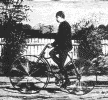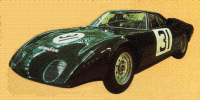History of the Rover Company.
Contents of this page:

The name `Rover' derives from the Rover safety cycle, experimented with by Starley and Sutton in 1884 and refined over subsequent years. In that era most bicycles were `ordinaries', or `penny-farthings', and far from safe as taking a header over the front wheel was a real risk. Others made safety cycles at about this time but Starley and Sutton's Rover was very successful. The forefathers of the car company must have been mindful of exports even then for `rover' is still the word for `bike' in Poland.
For more information see `King of the Road' by A.Richie [books].
During world war II, Rover worked on the new gas turbine engines. This work subsequently moved to Rolls Royce who went on to become a major manufacturer of jet engines after the war. However Rover maintained an interest in gas turbines and made a number of gas turbine powered cars. An early one of these (Jet 1) is in the Science Museum, London.
The Rover T4 looks for all the world like a modified P6 / Rover 2000 / 3500 fitted with a gas turbine engine. The Rover 2000 had unusual front suspension making for a wide engine bay, possibly to fit the gas turbine. The gas turbine version did not go into production but the 3.5L V8 later fitted in the space provided.

A Rover/BRM gas turbine powered coupe (pictured) performed creditably in the 1963 LeMans 24 hour race, driven by Graham Hill and Richie Ginther. It averaged 107.8 mph and had a top speed of 142 mph down the Mulsanne straight. It ran again in 1965, averaging 98.8 mph, fitted with a 126 h.p. Rover turbine. Maximum rpm were 60,000! It is very difficult to make a gas turbine that is both small and fuel efficient. The second run may have been slower either because the car had a less powerful engine, or because it was fitted with a heat-exchanger (regenerator), or both. The car is now held at the British Motor Industry Heritage Trust museum at Gaydon.
Some Sources:
In 1988 British Aerospace bought Rover Group (which includes Land-Rover). Rover Group was sold to BMW in 1994.
In April 2000, BMW announced that it would break up and sell Rover, selling Land Rover (to Ford), keeping the new Mini, and selling the rest of the car section to an investment company `Alchemy' which would make and sell sports cars under the `MG' name (the British government was not pleased!). By late April, the Alchemy deal may have fallen through with a rival `Phoenix' group, led by an ex-Rover executive, still in the race.